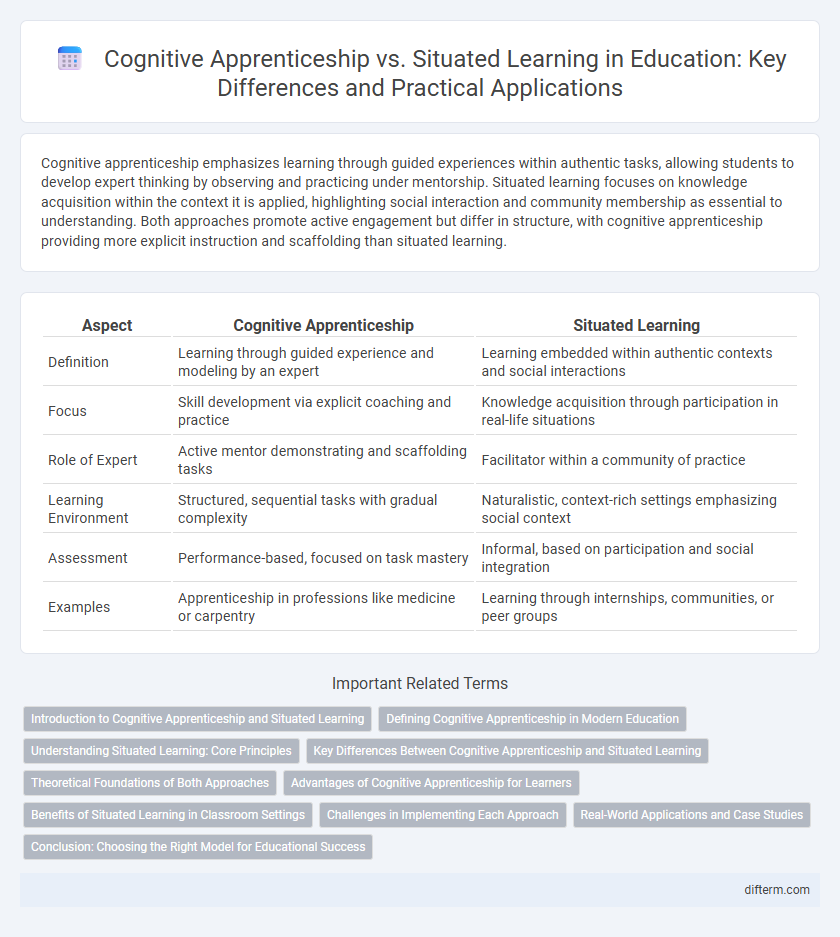Cognitive apprenticeship emphasizes learning through guided experiences within authentic tasks, allowing students to develop expert thinking by observing and practicing under mentorship. Situated learning focuses on knowledge acquisition within the context it is applied, highlighting social interaction and community membership as essential to understanding. Both approaches promote active engagement but differ in structure, with cognitive apprenticeship providing more explicit instruction and scaffolding than situated learning.
Table of Comparison
| Aspect | Cognitive Apprenticeship | Situated Learning |
|---|---|---|
| Definition | Learning through guided experience and modeling by an expert | Learning embedded within authentic contexts and social interactions |
| Focus | Skill development via explicit coaching and practice | Knowledge acquisition through participation in real-life situations |
| Role of Expert | Active mentor demonstrating and scaffolding tasks | Facilitator within a community of practice |
| Learning Environment | Structured, sequential tasks with gradual complexity | Naturalistic, context-rich settings emphasizing social context |
| Assessment | Performance-based, focused on task mastery | Informal, based on participation and social integration |
| Examples | Apprenticeship in professions like medicine or carpentry | Learning through internships, communities, or peer groups |
Introduction to Cognitive Apprenticeship and Situated Learning
Cognitive apprenticeship emphasizes learning through guided experiences with experts, focusing on making thinking processes visible while engaging learners in authentic tasks. Situated learning occurs within real-world contexts where knowledge is co-constructed through social interaction and participation in communities of practice. Both approaches highlight learning as a social, contextually grounded process, but cognitive apprenticeship stresses explicit modeling and coaching, whereas situated learning prioritizes immersion and authentic engagement.
Defining Cognitive Apprenticeship in Modern Education
Cognitive apprenticeship in modern education emphasizes learning through guided experiences where learners develop problem-solving skills by working alongside experts in authentic contexts. This approach integrates methods such as modeling, coaching, scaffolding, and articulation to make thinking processes visible and accessible. It contrasts with purely situated learning by intentionally designing interactions to foster skill acquisition and reflection within real-world tasks.
Understanding Situated Learning: Core Principles
Situated learning emphasizes authentic contexts where knowledge is acquired through participation in real-life activities, fostering deeper comprehension and skill mastery. Core principles include social interaction, collaboration, and learning through apprenticeship within a community of practice, allowing learners to engage in meaningful tasks. Unlike cognitive apprenticeship, situated learning prioritizes context-driven knowledge embedded in everyday experiences over explicit instruction.
Key Differences Between Cognitive Apprenticeship and Situated Learning
Cognitive apprenticeship emphasizes explicit teaching of cognitive and metacognitive skills through modeling, coaching, and scaffolding within authentic tasks, whereas situated learning centers on learning through participation in social and cultural contexts without formal instruction. The key difference lies in cognitive apprenticeship's structured guidance fostering skill development, while situated learning relies on immersion and interaction within a community of practice to acquire knowledge. Both approaches highlight contextual learning but differ in the level of instructional support and learner autonomy.
Theoretical Foundations of Both Approaches
Cognitive apprenticeship roots itself in social learning theory, emphasizing guided experiences by experts to develop cognitive and metacognitive skills through modeling, scaffolding, and coaching. Situated learning theory centers on the concept that knowledge is best acquired within authentic contexts through legitimate peripheral participation in communities of practice. Both approaches highlight social interaction and contextualized learning but differ in their focus on expert-novice relationships versus immersion in social environments for skill acquisition.
Advantages of Cognitive Apprenticeship for Learners
Cognitive apprenticeship enhances learner understanding by integrating expert modeling, coaching, and scaffolding within authentic tasks, promoting deep skill acquisition and problem-solving abilities. It facilitates gradual internalization of complex cognitive and metacognitive strategies through social interaction and active participation in real-world contexts. This approach improves learner engagement and retention by making abstract concepts concrete and accessible through guided practice and reflection.
Benefits of Situated Learning in Classroom Settings
Situated learning enhances student engagement by immersing learners in authentic contexts that mirror real-life scenarios, fostering deeper understanding and practical skill application. It promotes social interaction and collaboration through community participation, allowing learners to construct knowledge jointly with peers and mentors. This approach facilitates the transfer of learning to actual environments, improving retention and empowering students to tackle complex, real-world problems effectively.
Challenges in Implementing Each Approach
Cognitive apprenticeship faces challenges such as the need for skilled mentors who can articulate tacit knowledge and the difficulty in scaling personalized guidance across diverse learners. Situated learning struggles with creating authentic contexts within formal educational settings, often limited by institutional constraints and resources that inhibit genuine community participation. Both approaches require significant adaptation to existing curricula to effectively integrate experiential and context-based learning methods.
Real-World Applications and Case Studies
Cognitive apprenticeship emphasizes learning through guided experience and modeling by experts, integrating real-world applications to develop practical problem-solving skills within authentic contexts. Situated learning situates knowledge acquisition within social and physical environments, using case studies that mirror real-life scenarios to enhance relevant skill transfer and learner engagement. Both approaches prioritize immersion in genuine tasks, but cognitive apprenticeship focuses more on expert-guided mentorship while situated learning centers on contextual social interaction.
Conclusion: Choosing the Right Model for Educational Success
Selecting the ideal educational model hinges on aligning cognitive apprenticeship with situated learning to optimize skill acquisition and contextual understanding. Cognitive apprenticeship excels in developing procedural expertise through guided practice, while situated learning fosters deep comprehension by embedding knowledge within authentic environments. Educators should integrate both approaches strategically to enhance learner engagement and real-world application.
cognitive apprenticeship vs situated learning Infographic

 difterm.com
difterm.com